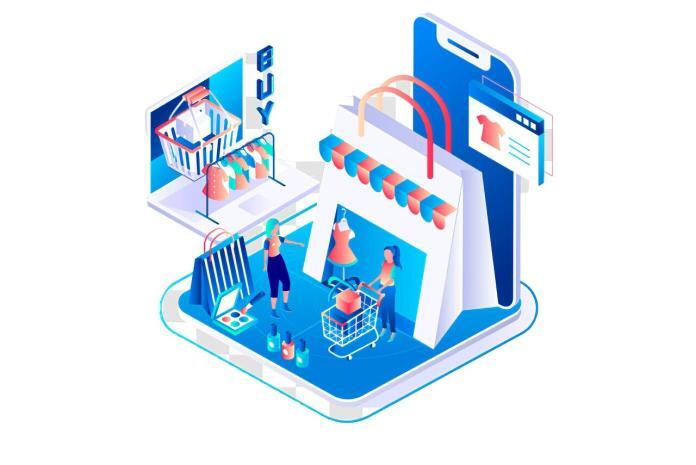Recent e-commerce statistics reveal that there are an astounding 12 to 24 million e-commerce sites globally. However, only a tiny percentage of these sites will thrive long-term.
You can attribute an e-commerce business’s success to various factors, but effective use of technology is one of the most critical. Having proper tech tools at your disposal can fast-track your expansion online.
You’ve landed in the right place if you’re looking for guidance on tech tools that can facilitate growth. Let’s explore six tools you should leverage to find your footing in the e-commerce world.
Marketing Tools
Thriving in the digital age requires a unique strategy. And you need something to help you execute that strategy. Insert technology here. Many tech tools are available to help you piece together and strengthen your digital presence.
A robust digital presence is integral to e-commerce success. But as more and more companies find their way into the online world, creating a memorable presence becomes that much harder.
Marketing tools can help.
It’s nearly impossible for e-commerce companies to gain momentum without effective marketing. However, this doesn’t mean you have to spend a lot of money on marketing tools.
Focus on low-cost marketing such as search engine optimization (SEO) tools — like SEO Powersuite’s free version, Google’s Keyword Planner, or Long Tail Pro. Prioritizing SEO is essential because people flock to search engines to learn more about and purchase products. You want to ensure your business pops up on the first page when people are searching for the products you sell.
Then, turn your focus to social media management tools. With millions of people on these platforms daily researching e-commerce brands and buying from them, you need to establish yourself on them as well.
Look for publishing tools that allow you to create and schedule posts ahead of time. For example, you can schedule up to 10 posts for three social media profiles with the free version of Buffer.
Social listening tools are also important. They’ll help you stay on top of the conversations surrounding your brand, competitors, and the e-commerce industry. Awario is one of the most affordable social listening tools out there. Or, try Hootsuite if your budget is a little larger.
Video Creation Tools and Editing Software
Video creation tools and editing software may not seem like they should be on this list of technology that inspires e-commerce growth. But if you think about how important video content is nowadays, you must consider them essential to e-commerce growth.
Consumers are more likely to view and engage with a product video than they are a written blog post about a product. Product videos are entertaining and educational. When an e-commerce business perfects this blend, it can capture and keep consumers’ attention, convincing them to purchase your products over all the competition out there.
Many emerging e-commerce business owners have started recording product videos on their smartphones. Don’t let not having expensive camera equipment stop you. Instead, learn the best techniques for your video creation tools and master them.
DaVinci Resolve is a reliable free video editing software to start with. Then, look into purchasing Adobe Premiere Pro when your budget permits. It’s one of the best video editing software with various features and functions that can elevate any product video.
Customer Relationship Management (CRM) Software
CRM software could be considered a marketing tool, but it deserves its own section for what it can do for your e-commerce business. A CRM system can help you keep track of all your customer data, including their demographic information, purchases, and other interactions with your business.
An e-commerce business can deepen customer relationships by organizing and managing customer data. Not only will your business be able to attract more of its ideal customers, but it will also strengthen its customer retention strategies.
Hubspot CRM Software is an excellent option. Even the free version has core functions like storing contact information, generating leads, tracking sales activity, and releasing customer analytics reports.
Analytics Tools
Data is a powerful tool for e-commerce businesses. You can boost all aspects of your e-commerce operation if you know how to collect, analyze, and use data effectively.
For example, you can learn more about your customers and tailor your marketing campaigns to them. You can discover the effectiveness of sales channels and make insightful adjustments to them that result in more profit. You can also use analytics to track the productivity of your internal team.
Google Analytics is the go-to analytics tool for e-commerce websites. But paying for platforms like Crazy Egg and Glew.io will be much more effective because you can track analytics on all your sales channels in one place.
Cybersecurity Tools
As our online engagement increases daily, the digital world becomes much more enticing to cybercriminals. Not only are consumers sharing and storing confidential information online, but so are businesses.
E-commerce businesses collect and store a lot of private customer information, like their name, email address, debit or credit card number, and home address. In addition, you have a lot of confidential business information on your networks, like profit reports and licenses.
Sophisticated cybercriminals can do more with just a customer’s name and address or your business address and phone number than you think. So, cybersecurity tools are a must to protect your customers and your company.
The platform would have built-in cybersecurity protection if you used a website builder to create your e-commerce site. However, its strength depends on the plan you selected. You can take your cybersecurity measures to the next level with well-known security tools from Woopra or Trustwave.
Price Comparison Tool
One of the most challenging things about running an e-commerce business is pricing.
If you price too high, you won’t get a constant influx of customers. On the other hand, if you price too low, consumers might not see your business as trustworthy and will refrain from making purchases. And if your prices aren’t somewhere close to similar e-commerce stores, you’ll lose customers to the competition.
Ultimately, proper pricing is critical to consistent growth. So, investing in a price comparison tool is a smart business move. This tool helps ensure you’re pricing your products appropriately now and in the future.
Skuuudle is a top-tier price comparison tool. It tracks competitor pricing, offers market analysis, and uses artificial intelligence and deep analytics to develop the best pricing strategies for your products.
Key elements of E-commerce growth
The growth of an e-commerce business involves a combination of strategic planning, effective execution, and adaptation to changing market dynamics. Here are key elements that contribute to the growth of an e-commerce business:
- User-Friendly Website:
- Element: A user-friendly and visually appealing website is essential. Ensure easy navigation, a clear layout, and a seamless checkout process. Mobile responsiveness is crucial as well, given the increasing use of smartphones for online shopping.
- Quality Product Listings:
- Element: Provide detailed and accurate product listings, including high-quality images, product descriptions, and specifications. Clear and compelling product information helps build trust with customers.
- Effective Search Engine Optimization (SEO):
- Element: Implement SEO strategies to improve your website’s visibility on search engines. Optimize product pages, use relevant keywords, and create high-quality content to attract organic traffic.
- Multi-Channel Selling:
- Element: Expand your reach by selling on multiple channels, such as marketplaces (Amazon, eBay), social media platforms, and other e-commerce platforms. Diversifying your sales channels can attract a broader audience.
- Customer-Centric Approach:
- Element: Prioritize customer satisfaction. Provide excellent customer service, address queries promptly, and offer a hassle-free return policy. Positive customer experiences lead to repeat business and positive word-of-mouth.
- Personalization and Customer Segmentation:
- Element: Implement personalization strategies by analyzing customer data and tailoring the shopping experience based on individual preferences. Customer segmentation allows you to target specific groups with relevant promotions.
- Secure Payment Options:
- Element: Offer secure and convenient payment options. Ensure that your payment gateway is reliable, supports various payment methods, and provides a secure environment for transactions.
- Data Analytics and Insights:
- Element: Use data analytics to gain insights into customer behavior, preferences, and trends. Analyzing data can help you make informed decisions, optimize marketing strategies, and enhance the overall customer experience.
- Strategic Marketing Campaigns:
- Element: Develop and execute strategic marketing campaigns across various channels. Utilize social media, email marketing, content marketing, and paid advertising to increase brand visibility and attract new customers.
- Streamlined Supply Chain and Logistics:
- Element: Optimize your supply chain and logistics for efficiency. Fast and reliable shipping options, accurate inventory management, and efficient order fulfillment contribute to a positive customer experience.
- Loyalty Programs and Retention Strategies:
- Element: Implement loyalty programs to reward repeat customers. Create retention strategies, such as exclusive promotions and personalized offers, to keep customers engaged and encourage repeat purchases.
- Adaptation to Market Trends:
- Element: Stay abreast of e-commerce trends and adapt your business accordingly. Embrace emerging technologies, such as augmented reality (AR) or voice commerce, and respond to changing consumer behaviors.
- Continuous Testing and Optimization:
- Element: Regularly test different elements of your website, marketing strategies, and user experience. A/B testing can help identify what works best, allowing you to continually optimize and improve.
- Social Proof and Reviews:
- Element: Leverage social proof through customer reviews, testimonials, and user-generated content. Positive reviews build trust and credibility, influencing potential customers to make a purchase.
By focusing on these key elements, e-commerce businesses can create a strong foundation for growth and adapt to the dynamic nature of the online marketplace. Continuous improvement and a customer-centric approach are fundamental to sustained success in the e-commerce industry.
Conclusion
Simply put, you need technology to facilitate e-commerce growth. There’s no way around the effective use of tech tools if the goal is to thrive. So, educate yourself further on the technology above before deciding if they deserve a permanent place in your e-commerce operation.
You may also want to read,









Since the admin of this website is working, no doubt very quickly it will be famous, due to its feature contents.